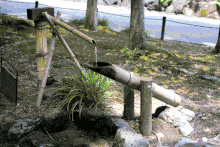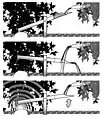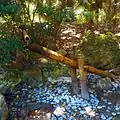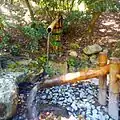Shishi-odoshi
Shishi-odoshi (鹿威し) ('scaredeer' or 'scareboar'), in a wide sense, refers to Japanese devices made to frighten away animals which pose a threat to agriculture, such as the kakashi (scarecrow), naruko (clappers) and sōzu. In a narrower sense, it is synonymous with sōzu.

A sōzu is a type of water fountain used in Japanese gardens. It consists of a segmented tube, usually of bamboo, pivoted to one side of its balance point. At rest, its heavier end is down and resting against a rock. A trickle of water into the upper end of the tube accumulates and eventually moves the tube's centre of gravity past the pivot, causing the tube to rotate and dump out the water. The heavier end then falls back against the rock, making a sharp sound, and the cycle repeats.[1]
The noise created by these fountains was intended to startle any herbivores such as deer or boars which may be grazing on the plants in the garden, but shishi-odoshi are now a part of the visual and aural design of gardens and are used primarily for their aesthetic value.[2]
Gallery
 Diagram of operation
Diagram of operation
 Morikami Museum and Gardens - shishi-odoshi filling up
Morikami Museum and Gardens - shishi-odoshi filling up Emptying
Emptying
See also
- Monjolo
- Suikinkutsu
- Water scoop (hydropower)
- Tsukubai (a basin often used in conjunction)
References
- Cerwén, Gunnar (November 22, 2019). "Listening to Japanese Gardens: An Autoethnographic Study on the Soundscape Action Design Tool". International Journal of Environmental Research and Public Health. 16 (23): 4648. doi:10.3390/ijerph16234648. PMC 6926712. PMID 31766643.
- Young, Michiko; Young, David (May 21, 2019). The Art of the Japanese Garden: History / Culture / Design. Tuttle Publishing. ISBN 9781462905829. Retrieved 17 February 2020.
